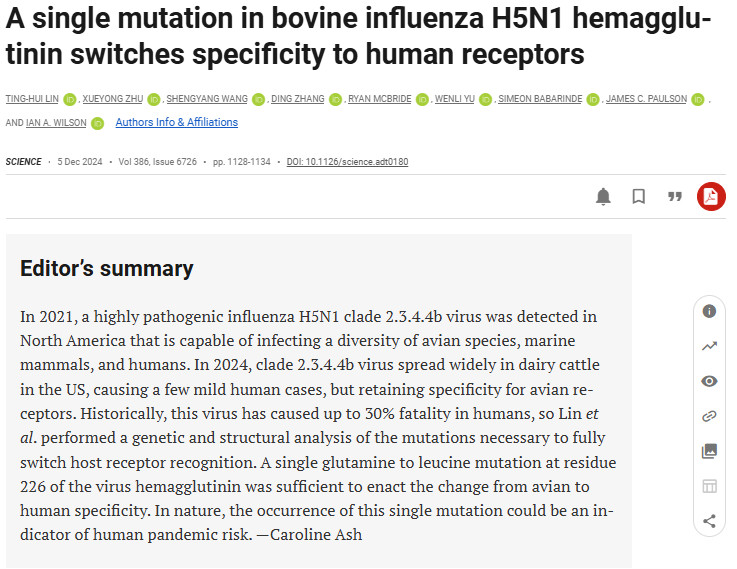In recent H5N1 bird flu studies news, a study published on December 5, 2024 found that a single mutation in the HA gene of a recent H5N1 virus caused a receptor binding switch: meaning the preferred receptors for this virus changed from avian a-3 receptors to human a-6 receptors. This finding has gotten a lot of attention. The study itself is an interesting read, although quite technical, and the results are a bit alarming.

What are “receptors” and what is “binding”?
Without getting too technical, binding is when a virus attaches itself to a host cell, and the virus does this by binding to a receptor on the outside of that cell. As noted by the CDC: “A major determinant of a virus-host range is receptor availability. Influenza A viruses use host sialic acids as their receptors for initial attachment and entry into the cells.” That’s the key: flu viruses, including bird flu viruses, find tiny things called “sialic acids” which act as receptors that the virus attaches to and then infects the cell.
But not all flu viruses attach to all types of receptors well. And that has to do with how these receptors are linked to the host cell. Bird flu viruses, like H5N1, typically attach to receptors that are linked to a cell by what’s called an alpha 2-3 linkage, while human flu viruses typically attach to receptors that are linked by an alpha 2-6 linkage. That’s the gist of it: bird flu likes a-3 receptors, human flu likes a-6 receptors.
Why does bird flu receptor binding matter to human health?
So why is this important? Because of where these different receptors are found. Humans have a-6 receptors in the upper respiratory tract, and that’s where our coughs and sneezes come from. When flu season comes along and everyone is coughing and sneezing, it is a human flu strain that has bound to those a-6 receptors, invaded those cells, and is now spreading through the air. Bird flu however, prefers a-3 receptors, and humans do not have those in their upper respiratory tract (but we do have them in the lower respiratory tract).
So bird flu viruses, like H5N1, would typically only bind well to cell receptors located lower in the respiratory airways, like the lungs. H5N1 has a much harder time gaining a foothold in humans because it has a harder time transmitting between humans, for which we are all very lucky. This is because the virus can’t attach to and infect the cells higher up in our airways, and thus can’t replicate in the areas most likely to lead to coughs and sneezes, thereby promoting viral spread.
If a bird flu virus could attach to those a-6 receptors found higher up in our respiratory system and infect those cells, it would have a better chance of spreading from a sick person to other people. And that’s why receptor binding is a key focus when considering potential risks to public health of bird flu viruses, like H5N1. It’s also why receptor binding is a major focus of the scientific studies on bird flu, especially now.

H5N1 receptor binding switch by one mutation: HA Q226L
Which brings us to the recent study getting so much attention in the news: “A single mutation in bovine influenza H5N1 hemagglutinin switches specificity to human receptors. The study used the H5N1 virus isolated from the first human case in Texas, A/Texas/37/2024. This H5N1 virus was genetically modified in the lab, in which a single mutation, HA Q226L, was inserted into the HA gene of the virus.
Interestingly, when that Q226L mutation was put into this H5N1 bird flu virus, the “binding specificity was completely switched from avian-type to human-type receptors” in all three of the binding tests performed. Further, there was “no detectable binding to α2-3” receptors. So this was not just dual binding, where the bird flu virus retains some of its original preference for a-3 receptors while also gaining preference for a-6, but an entire switch to preferring those human a-6 receptors.
Further, in one of the tests, it was found that the mutated H5N1 virus actually bound more strongly to a-6 receptors than the human H1N1 control virus did. That’s interesting. One would not necessarily think that a bird flu virus, even one mutated in the lab, would bind to human cells better than a human flu virus. The study also noted that the receptor switch facilitated by the Q226L mutation was actually enhanced when that mutation was combined with another mutation: N224K. The study did note that this a-6 binding was “weaker” than the a-3 binding, such that the original H5N1 virus bound more strongly to avian-style receptors than the mutated virus bound to human-style receptors, but the binding switch after Q226L was added was “clear and pronounced in all three assays.”
As to the mutation itself, Q226L has been seen before and is known to be associated with increased binding to human a-6 receptors. Indeed, the importance of the Q226L mutation for receptor binding was noted in a January 2012 study, which also involved mutating H5N1 viruses in the lab to examine receptor binding, by identifying key changes “needed to affect receptor specificity changes in influenza, and for monitoring the evolution of H5N1 field viruses toward a potentially pandemic form.”
Additional examples of the HA Q226L mutation include:
-
- This mutation was discussed in a recent study that used “deep mutational scanning” to examine all potential amino acid mutations in H5 viruses. Per the study: “The HA mutations that specifically enhanced entry into α2-6 versus α2-3 cells were mostly at a handful of sites in the sialic-acid binding pocket. Multiple mutations to site Q226 strongly increased HA’s preference for α2-6-versus α2-3-linked sialic acids in our deep mutational scanning.”
-
- In a June 2021 study which showed airborne transmission of an H3N8 virus between ferrets, the Q226L mutation was quickly acquired upon infection indicating a natural adaptation process.
-
- Q226L was one of two mutations (the other being G228S) that caused the receptor binding switch for the H2N2 pandemic of 1957.
-
- Most recently, this mutation was found in the initial sequencing of the H5N1 virus from the teenager in Canada, who still remains hospitalized.

Notably, this is not the first recent bird flu study to find that an H5N1 virus could bind to human a-6 receptors. A study published in July 2024 found that an H5N1 virus isolated from the milk of an infected dairy cow in New Mexico spread by respiratory transmission to 1/4 contact ferrets, but at very low levels. The contact ferret had evidence of seroconversion, meaning a low level of viral transmission not resulting in detectable virus. But perhaps the most alarming finding was the results of the receptor binding tests: the cow H5N1 virus bound to both α2,3- and α2,6-linked sialic acids, indicating the virus could bind to both types of receptors. Thus, the authors of the study concluded that “the Cow-H5N1 virus may have the ability to bind to cells in the upper respiratory tract of humans.” That was alarming news when that study was published, although something strange also happened. It seemed like the scientific community as a whole approached these results with caution and sought ways to dismiss them. It was almost as if they did not want to suggest that H5N1 had reached a critical milestone. Maybe that was just my take, but I distinctly remember there being a lot of push back when these results came out.
And now we have this newer study finding something similar, if not much more concerning, than the first study. Indeed, the study published in July found that the H5N1 virus from cow milk in New Mexico bound to both human and bird receptors, thus indicating that the virus retained some of its original binding preference while also being able to bind to a-6. But this study published in December noted that the mutated H5N1 Texas virus bound to a-6 receptors and did not bind to a-3 receptors at all. I really don’t know which is worse.

To be sure, what happens in the laboratory in no way dictates what happens in nature, just as the results of some studies do not dictate the results of others. With the scientific studies on bird flu viruses there are always going to be differing results because not all studies are done the same, and not all H5N1 viruses act the same.
Indeed, this new study hit on this last point, albeit in an incredibly technical way that makes it difficult to digest for the everyday human. There are numerous diagrams and visualizations that remind me of how confused I was in chemistry class, but which show “the structural basis for this preferential receptor recognition.” So the authors put together the structures of the mutated virus in the study and compared it with others to see where it looked different and how that compared to its ability to bind to human a-6 receptors. This had to do with how the amino acids that make up the viral genome interact with each other, particularly around the receptor binding site. It’s fascinating to read something so detailed on this topic, and it illustrates the complex nature of how these bird flu viruses operate, and operate differently from each other. Hopefully it will also provide insights for further research and application into developing medical countermeasures targeting this clade of H5N1 viruses.
What are the risks to human health if H5N1 can bind to human receptors?
Given these findings, is there an increased risk to public health, especially since H5N1 continues to circulate through dairy cattle and poultry farms?
The capability of a bird flu virus to switch its receptor binding preference from the avian-like a-3 receptors to the human-like a-6 receptors is considered one of the prerequisites to a potential pandemic. Indeed, receptor binding is a key competent of the CDC’s updates about H5N1 and the risk to human health, i.e.: “To date, HPAI A(H5N1) viruses currently circulating most commonly in birds and poultry, with spillover to mammals and humans, do not have the ability to efficiently bind to receptors that predominate in the human upper respiratory tract. This is a major reason why the current risk to the public from HPAI A(H5N1) viruses remains low.” (CDC Technical Report: Highly Pathogenic Avian Influenza A(H5N1) Viruses, June 9, 2024). The authors of the recent study state the same: “A switch from avian- to human-type receptor specificity is considered a major risk factor for transmission in humans. For this reason, our observation that the single Texas H5 HA Gln226Leu [E226K] mutation can switch receptor specificity is a clear concern.” It sure is.
But the authors of this study also note that a switch in receptor binding may be necessary, but is not itself sufficient, to cause an outbreak or a pandemic. If you’ve read as many studies as I have you will know that they all do that, they always say something like that, and usually near the end of the paper. It is true but it doesn’t really make me feel better.
We need to remember that there is just so much truly unknown about influenza. For every mutation the scientific community knows can enhance mammalian adaptation, there are probably countless others we don’t know about. Moreover, even the mutations we do know about might act differently in some flu viruses than others. This was noted in the recent study discussed above, in which additional mutations were inserted into the H5N1 Texas human virus, mutations that increased binding in prior studies, but which did not increase binding to a-6 receptors in this study. Not all flu viruses act the same, and we can only know what happens in nature as it happens.
In truth, all we really know is that bird flu viruses, like all flu viruses, are constantly changing. They are mutating, adapting, reinventing themselves all the time, and if and when this ongoing evolutionary process eventually creates something that will be a problem for humans remains to be seen.
Until next time.
For more bird flu updates and research study analysis, be sure to read my other articles and follow me on social media.
Leave a comment and join the discussion, and always feel free to reach out!



Valuable insights backed by real-life examples; it can’t get better than that.
Your prose flow so seamlessly that I easily lose track of time while engrossing myself in your blog.
Your excitement is infectious. It’s difficult not to get pumped up about the topics you explore.
Pingback: The First Fatal Case of H5N1 Bird Flu in the U.S. - Bird Flu Studies
Nice blog here! Also your site loads up fast! What web host are you using? Can I get your affiliate link to your host? I wish my web site loaded up as quickly as yours lol
some times its a pain in the ass to read what blog owners wrote but this website is really user pleasant! .
I like the helpful info you provide in your articles. I will bookmark your weblog and check again here frequently. I am quite sure I will learn many new stuff right here! Best of luck for the next!
A formidable share, I simply given this onto a colleague who was doing just a little evaluation on this. And he in truth purchased me breakfast as a result of I discovered it for him.. smile. So let me reword that: Thnx for the deal with! However yeah Thnkx for spending the time to debate this, I really feel strongly about it and love reading extra on this topic. If attainable, as you turn into expertise, would you mind updating your blog with extra particulars? It is highly useful for me. Large thumb up for this weblog publish!